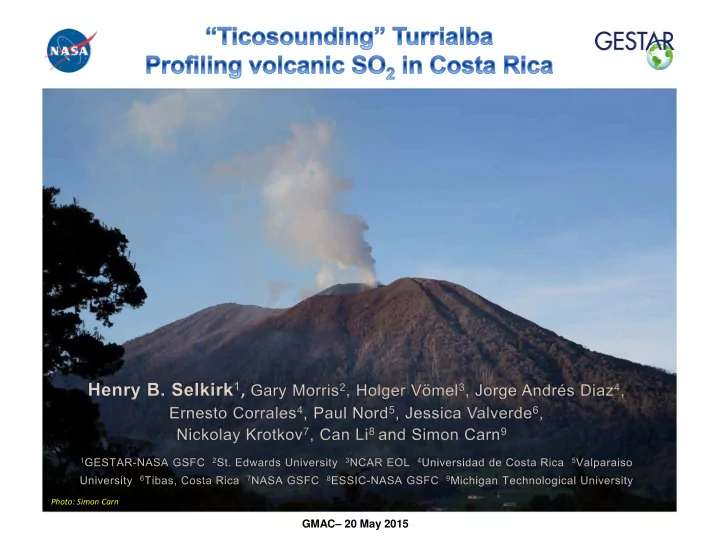

Photo: Simon Carn GMAC– 20 May 2015
The Ticosonde opportunity The NASA Ticosonde project has been Beginning in 2006, we began to see launching ozone (ECC) and water vapor from time to time ozone profiles with (CFH) balloon sondes since 2005 at 3 distinct notches, mostly below 5 km sites around San José, Costa Rica Heredia Volcán Alajuela Turrialba Volcán San Pedro Irazú San José It seemed likely that these notches The San José metro area lies just to the were caused by volcanic plume SO 2 west of Volcán Turrialba (3480 m) which entering the ozone sonde and causing became active again in the mid-1990s. interference of the O 3 detection GMAC– 20 May 2015
Dual ozone sonde profiling beginning 2012 θ SO 2 SJ470 O 3 (filtered) 13 Mar 2015 Tropospheric SO 2 column = 1.7 DU Upper O 3 ascent Traj #3 SO2 layer O 3 descent SO 2 ascent Traj #2 Lower SO 2 descent SO2 layer Traj #1 Theta ascent Theta descent trop_so2_o3mr_2015031312 GMAC– 20 May 2015
OUTLINE of the TALK • History of SO 2 notching of Ticosonde ozone profiles • Dual-sonde profiling technique for SO 2 • The dual-sonde program in Costa Rica since 2013 • Inter-comparison with single-sonde notch interference method • Sample comparisons to two satellite retrievals • Validation opportunities and challenges • Summary and science questions GMAC– 20 May 2015
2006-08 2014-07 NEARLY A DECADE OF NOTCHING I A Notch-inferred SO 2 columns 2007-08 2013-04 E F I H B G H C D B 2008-01 2012-04 A G C 2009-06 2010-02 2011-03 E F D
Ticosonde ozone sonde notch history Year All ozone sondes # sondes with Dual ozone sondes (single and dual) notches from 7/2005 28 0 2006 76 1 2007 43 8 2008 48 7 2009 26 3 2010 40 17 2011 46 12 2012 43 16 1 2013 42 18 6 2014 34 15 18 2015 (to present) 14 10 5 TOTAL 439 107 30 Data Access Ozonesondes (SHADOZ) at Aura Validation Data Center: http://avdc.gsfc.nasa.gov Dual ozonesondes at Valparaiso : http://physics.valpo.edu/ozone/ticosonde_so2.html
Dual ozone sonde SO 2 profiling Measurement SO 2 measurement principle of the ECC principle ozonesonde SO 2 interferes with the O 3 Ozone flowing through cathode measurement on a one-to- upsets equilbrium between one basis. One approach negative iodide ions and then is to fly two ozone molecular iodine, sondes side by side, one with an SO 2 scrubber filter on intake, and the second unfiltered. In simple terms To re-establish equilibrium, 2 (and as long as [O 3 ] > [SO 2 ]), electrons must flow from anode to cathode , viz., Interference by SO 2 Reference: Morris, et al., 2010, A SO 2 short-circuits the anode balloon sounding technique for measuring SO2 plumes, J. Atmos. current by reacting with water Ocean. Tech, 27, 1318-1330, doi: to yield a sulfate ion and two 10.1175/2010JTECHA1436.1 electrons, viz. , Dual ozone sonde setup as used by Morris et al. , 2010. Note SO 2 filter on RH sonde. GMAC– 20 May 2015
Dual-sonde difference vs. single-sonde notch inference method 4.32 DU SO 2 1.81 DU SO 2 Legend: O 3 SO 2 DUAL SO 2 Inferred Estimate of column SO 2 from shallow, Unusual notch depth and its saturation lead to unsaturated notch close to dual-sonde estimate significant underestimates using both methods NOAA GMD is developing a modified ECC board that will enable measurement of negative voltage excursions – eliminate zero truncation when [SO 2 ] > [O ⇑ ] GMAC– 20 May 2015
Sample Comparisons of Dual Sonde columns to OMI LF and OMPS PCA lower trop (TRL) retrievals OMI LF TRL OMPS PCA TRL 18 Oct 2013 2.6 DU 0.5-1 DU max TRL ≈ 1 DU max TRL: >2 DU OMI LF TRL OMPS PCA TRL 7 Feb 2014 1.6 DU max TRL ≈ 1 DU max TRL: ~1.3 DU OMI LF TRL: approaches dual sonde column; noisy and data loss in row anomaly OMPS PCA TRL: less noise, but lower resolution and significant underestimate GMAC– 20 May 2015
SATELLITE VALIDATION Opportunities and Challenges Notch-inference SO 2 column measurements validate Aura OMI LF and PCA retrievals, 2006-present Dual sonde SO 2 column measurements validate OMI and OMPS (on Suomi-NPP) retrievals, 2013 – present 22 remaining dual sondes Hope to validate TropOMI (summer 2016 launch) Challenges/Questions: Saturated notches: Standard ECC cannot measure negative voltages, so restricted to [SO2] ≤ [O3] (testing new sonde from GMD) Overcast: Reduces sample size, particularly in rainy season (June- October) (tighten up launch protocols; focus on dry season) Sampling scale differences, sonde vs FOV: How representative are sonde samples? (plume dispersion modeling ) GMAC– 20 May 2015
SUMMARY Frequent observations of SO 2 interference in ozone sondes at San José, Costa Rica, downwind of Volcán Turrialba • Notches in 107 of over 400 ozone profiles since July 2005 Dual sondes unequivocally demonstrate that notches are due to SO 2 • Notches in 19 of 30 dual sonde profiles since February 2012 ONGOING and FUTURE WORK: Continue single- and dual-sonde observations at Costa Rica Test GMD experimental board to extend range of SO 2 measurement Complete validation of SO 2 retrievals with single- and dual-sonde observations OMI – 2006 to present Suomi NPP – 2012 to present TropOMI in 2016? SCIENCE QUESTIONS: • How is plume dispersed and diluted between emission and sonde measurement several hours downstream? • Can we exclude the possibility that there is formation of sulfate particles in this time frame? GMAC– 20 May 2015
Recommend
More recommend